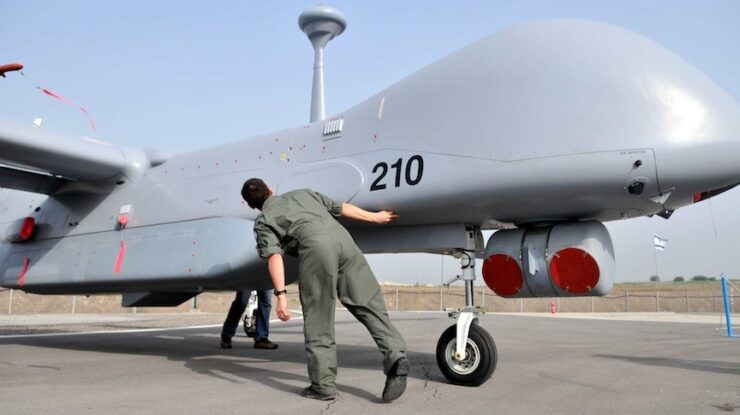
Tel Aviv: The Israeli Ministry of Defence is now trying to form a policy that will allow the export of the combat proven Israeli made armed UAVs. As reported by Raksha Anirveda the fact that Israel is using these UAVs, the details of which were classified for 20 years, Israeli defence companies were approached by some countries with an immediate demand for these UAVs immediately a day after the gag order was removed.
Historically the armed UAV’s have been developed after the US made Israel to terminate the Lavi fighter aircraft program. The Lavi fighter aircraft was developed by Israel Aerospace Industries (IAI). After three prototypes had accumulated many flight hours, heavy pressure from the US administration, brought the Israeli government to cancel it. The armed drones program dubbed “The Main Project” was born shortly afterwards.
The Israeli Ministry of Defence and the Israeli Air Force (IAF) decided that Israel being a UAV world power, can use these aerial platforms to launch missiles. The first armed UAV purchased by the Ministry of Defence for the Air Force was the Hermes 450 made by Elbit Systems, known in the Air Force as “Zick” ( Spark), and later also its enlarged version, the Hermes 900, known as “Kochav” (Star).
The armed Hermes -450 was put into service in 1990 and since then has been used to attack selected terror targets in Gaza and Lebanon. Elbit Systems then developed the larger version, the Hermes -900 that was also armed with special missiles made by IAI and Rafael. The extensive use of armed UAVs is one of the explanations to the fact that 80 % of the total flight hours performed by the IAF are with UAVs of different types of which some are highly classified. All these years more and more weapon systems have been adapted for use on the two UAVs and in recent years also on the IAI Heron-TP strategic UAV.
What brought the surprise decision to officially declare that the IAF is using these armed UAV’s is a mixture of events. Few years ago, the German air force decided to lease a number of IAI’s Heron TP for use in overseas operations. The contract included the lease of seven Heron – TP UAV. These are intended to support German operations in Africa and Asia. The UAV have been leased for a period of nine years and are capable of carrying “unique air-to-ground missiles”, according to German sources.
According to the German Defence Ministry, these weapons are capable of aborting their trajectory towards the target in case civilians may be hurt. The arming of the MALE UAV was in the heart of the internal debate in Germany before the deal was approved. German sources said that while vesting Israel, several options to use Israeli developed weapons were evaluated. An Israel defence source said that the German crews that came to an IAF base saw the armed UAVs and relayed the information to their commanders and that initiated the German interest in an armed Heron TP.
The IAI Heron TP is a multi-role, advanced, long range Medium Altitude Long Endurance (MALE) UAV for strategic missions. It is equipped with automatic taxi-takeoff and landing systems (ATOL), satellite communication (SATCOM) for extended range, fully redundant avionics and more.
According to IAI, the Heron TP was designed as a multi-mission platform to address local and international customers’ needs and to perform a variety of strategic missions, including intelligence gathering, surveillance, target acquisition and reconnaissance, using various payloads, with a high level of reliability. The Heron-TP IS 14 meters long, has a wing span of 26 meters and a max t/o weight of 5670 kg. It can carry a payload weighing 2700 kg. Max ceiling is 45000 feet, max speed is 220 knots and endurance is 30 hours. All this time, Israel officially has not reacted to any of the reports in Germany about an option to arm the leased UAVs.
But things in the Middle East are developing fast and are influenced by development in other parts of the world. The war in Ukraine proved that armed UAV can be very effective and the interest of the world in this combination stepped up. This interest created a pressure from the big Israeli defence industries to officially say that Israel is manufacturing and using armed UAVs. This pressure added to an earlier one from the industries influenced by the MTCR. Israel is not signed on this regime that limited the export of long range weapon systems, but acted according to it. When the US decided to make some concessions regarding the MTCR, the Israel defence systems started to make angry noises. The Industry claimed that this voluntary adherence to the MTCR is costing the industry “big money”. And then came the Russian invasion of Ukraine and the massive shipments of Turkish made UAV’s to the Ukraine army.
“It was obvious that things have changed and that Israel has to change its attitude if it does not want to lose more potential markets,” a senior defence sources said. The full details of the IAF’s fleet of armed UAVs are still classified but it can be said that the combination of long endurance UAVs with special payloads and special weapon systems enables Israel to “hit far and hard” as one defence source said.








